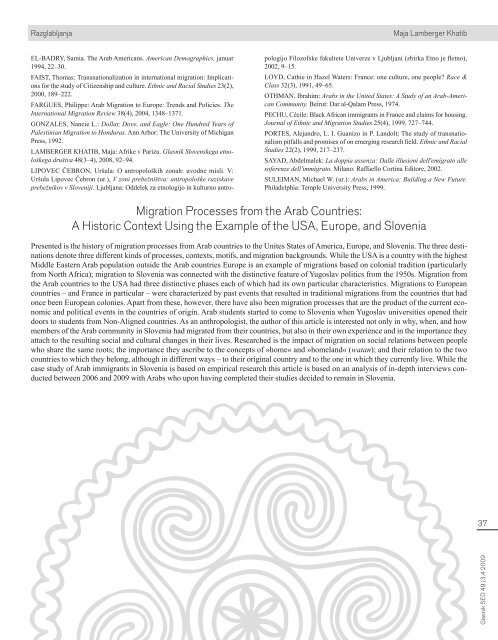lovenskega etnološkega društva - Slovensko etnološko društvo
lovenskega etnološkega društva - Slovensko etnološko društvo
lovenskega etnološkega društva - Slovensko etnološko društvo
Create successful ePaper yourself
Turn your PDF publications into a flip-book with our unique Google optimized e-Paper software.
Razglabljanja Maja Lamberger Khatib<br />
EL-BADRY, Samia. The Arab Americans. American Demographics, januar<br />
1994, 22–30.<br />
FAIST, Thomas: Transnationalization in international migration: Implications<br />
for the study of Citizenship and culture. Ethnic and Racial Studies 23(2),<br />
2000, 189–222.<br />
FARGUES, Philippe: Arab Migration to Europe: Trends and Policies. The<br />
International Migration Review 38(4), 2004, 1348–1371.<br />
GONZALES, Nancie L.: Dollar, Dove, and Eagle: One Hundred Years of<br />
Palestinian Migration to Honduras. Ann Arbor: The University of Michigan<br />
Press, 1992.<br />
LAMBERGER KHATIB, Maja: Afrike v Parizu. Glasnik S<strong>lovenskega</strong> <strong>etnološkega</strong><br />
<strong>društva</strong> 48(3–4), 2008, 92–94.<br />
LIPOVEC ČEBRON, Uršula: O antropoloških zonah: uvodne misli. V:<br />
Uršula Lipovec Čebron (ur.), V zoni prebežništva: antropološke raziskave<br />
prebežnikov v Sloveniji. Ljubljana: Oddelek za etnologijo in kulturno antro-<br />
pologijo Filozofske fakultete Univerze v Ljubljani (zbirka Etno je fletno),<br />
2002, 9–15.<br />
LOYD, Cathie in Hazel Waters: France: one culture, one people? Race &<br />
Class 32(3), 1991, 49–65.<br />
OTHMAN, Ibrahim: Arabs in the United States: A Study of an Arab-American<br />
Community. Beirut: Dar al-Qalam Press, 1974.<br />
PECHU, Cécile: Black African immigrants in France and claims for housing.<br />
Journal of Ethnic and Migration Studies 25(4), 1999, 727–744.<br />
PORTES, Alejandro, L. I. Guanizo in P. Landolt: The study of transnationalism<br />
pitfalls and promises of on emerging research field. Ethnic and Racial<br />
Studies 22(2), 1999, 217–237.<br />
SAYAD, Abdelmalek: La doppia assenza: Dalle illusioni dell'emigrato alle<br />
soferenze dell'immigrato. Milano: Raffaello Cortina Editore, 2002.<br />
SULEIMAN, Michael W. (ur.): Arabs in America: Building a New Future.<br />
Philadelphia: Temple University Press, 1999.<br />
Migration Processes from the Arab Countries:<br />
A Historic Context Using the Example of the USA, Europe, and Slovenia<br />
Presented is the history of migration processes from Arab countries to the Unites States of America, Europe, and Slovenia. The three destinations<br />
denote three different kinds of processes, contexts, motifs, and migration backgrounds. While the USA is a country with the highest<br />
Middle Eastern Arab population outside the Arab countries Europe is an example of migrations based on colonial tradition (particularly<br />
from North Africa); migration to Slovenia was connected with the distinctive feature of Yugoslav politics from the 1950s. Migration from<br />
the Arab countries to the USA had three distinctive phases each of which had its own particular characteristics. Migrations to European<br />
countries – and France in particular – were characterized by past events that resulted in traditional migrations from the countries that had<br />
once been European colonies. Apart from these, however, there have also been migration processes that are the product of the current economic<br />
and political events in the countries of origin. Arab students started to come to Slovenia when Yugoslav universities opened their<br />
doors to students from Non-Aligned countries. As an anthropologist, the author of this article is interested not only in why, when, and how<br />
members of the Arab community in Slovenia had migrated from their countries, but also in their own experience and in the importance they<br />
attach to the resulting social and cultural changes in their lives. Researched is the impact of migration on social relations between people<br />
who share the same roots; the importance they ascribe to the concepts of »home« and »homeland« (watan); and their relation to the two<br />
countries to which they belong, although in different ways – to their original country and to the one in which they currently live. While the<br />
case study of Arab immigrants in Slovenia is based on empirical research this article is based on an analysis of in-depth interviews conducted<br />
between 2006 and 2009 with Arabs who upon having completed their studies decided to remain in Slovenia.<br />
37<br />
Glasnik SED 49|3,4 2009




